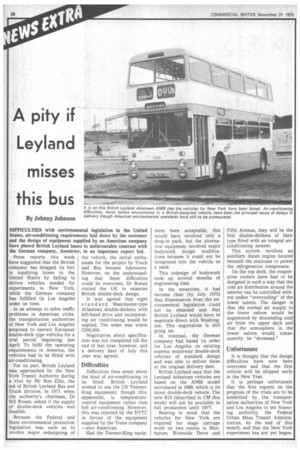A pity if Leyland misses this bus
Page 30

If you've noticed an error in this article please click here to report it so we can fix it.
By Johnny Johnson
DIFFICULTIES with environmental legislation in the United States, air-conditioning requirements laid down by the customer and the design of equipment supplied by an American company have placed British Leyland buses in unfavourable contrast with the German company, Auwarter, in an important export bid.
Press reports this week have suggested that the .British company has dragged its feet in supplying buses to the United States by failing to deliver vehicles needed for experiments in New York, while the German company has fulfilled its Los Angeles order on time.
In an attempt to solve traffic problems in American cities, the transportation authorities of New York and Los Angeles proposed to operate European double-deck type vehicles for a trial period beginning last April. To fulfil the operating requirements in America, the vehicles had to be fitted with air-conditioning.
For its part, British Leyland was approached by the New York Transit Authority during a visit by Mr Ron Ellis, the md of British Leyland Bus and Truck division, in 1971 when the authority's chairman, Dr Bill Ronan, asked if the supply of double-deck vehicles was feasible.
Because the Federal and 1 State environmental protection legislation was such as to involve major redesigning of the vehicle, the initial enthusiasm for the project by Truck and Bus became lukewarm. However, on the understanding that these difficulties could be overcome, Dr Ronan visited the UK to examine British double-deck design.
It was agreed that eight standard Manchester-type Atlantean double-deckers with left-hand drive and incorporating air conditioning would be :moiled. The order was worth e200,000.
Negotiation about specification was not completed till the end of last year, however, and a delivery date of July this year was agreed.
Difficulties
Difficulties then. arose about the kind of air-conditioning to be fitted. British Leyland wished to use the US ThermoKing equipment, though this, apparently, is temperaturecontrol equipment rather than full air-conditioning. However, this was rejected by the NYTC in favour of the equipment supplied by the Trane company —also American.
Had the Thermo-King equip ment been acceptable, this would have involved only a drop-in pack, but the alternative equipment involved major bodywork design modifications because it could not be integrated into the vehicle as a pack.
This redesign of bodywork took up several months of engineering time.
In the meantime, it had become clear (by July 1975) that dispensation from the environmental legislation could not be obtained and that British Leyland would have to negotiate direct with Washington. This negotiation is still going on.
In contrast, the German company had based its order for Los Angeles on existing express motorway double-deck vehicles of standard design and was able to deliver these at the original delivery date.
British Leyland says that the Leyland Atlantean vehicles are based on the AN68 model introduced in 1968, which is its latest double-deck vehicle. The new B15 (described in CM this week) will not be available in full production until 1977.
Bearing in mind that the vehicles for New York are required for stage carriage work on two routes in Manhattan, Riverside Drive and Fifth Avenue, they will be the first double-deckers of their type fitted with an integral airconditioning system.
This system involves an auxiliary diesel engine located beneath the staircase to power the refrigeration compressor.
On the top deck, the evaporative coolers have had to be designed in such a way that the cold air distribution around the interior can be controlled without undue "overcooling" of the lower saloon. The danger is that the normal air supply to the lower saloon would be augmented by descending cold air from the upper deck and that the atmosphere in the lower saloon would, consequently, be "drowned."
Unfortunate
It is thought that the design difficulties have now been overcome and that the first vehicle will be shipped early in the New Year.
It is perhaps unfortunate that the first reports on the progress c)f the trials are to be submitted by the transportation authorities of New York and Los Angeles to the financing authority, the Federal Urban Mass Transit Administration, by the end of this month, and that the New York experiment has not yet begun.








































































































